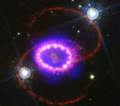Speaker
Ms
Sarah Wellons
(Harvard University)
Description
We present extensive radio observations of the nearby Type Ibc
supernovae (SNe Ibc) 2004cc, 2004dk, and 2004gq spanning $\Delta
t\approx 8-1800$ days after explosion. Using a dynamical model
developed for synchrotron emission from a slightly decelerated
blastwave, we estimate the velocity and energy of the fastest ejecta
and the density profile of the circumstellar medium. The blastwaves
of all three supernovae are characterized by non-relativistic
velocities of $\overline{v}\approx (0.1-25)c$ and associated energies
of $E\approx (2-10)\times 10^{47}$ erg, in line with the expectations
for a typical homologous explosion. Smooth, stellar wind
circumstellar density profiles are indicated by the early radio data
and we estimate the progenitor mass loss rates to be $\dot{M}\approx
(0.6-13)\times 10^{-5}~\rm M_{\odot}~yr^{-1}$ (wind velocity,
$v_w=10^3~\rm km~s^{-1}$). These properties are consistent with the
metallicity-dependent winds observed for Wolf-Rayet stars, the favored
progenitors of SNe Ibc including those associated with long-duration
gamma-ray bursts. However, at late time, each of these SNe show
evidence for abrupt radio variability that we attribute to large
density modulations (factor of $\sim 3-6$) at circumstellar radii of
$r\approx (1-50)\times 10^{16}$ cm. We infer enhanced mass loss rates
that approach or exceed $\dot{M}\sim 10^{-4}~M_{\odot}~{\rm yr}^{-1}$,
the saturation limit for Wolf-Rayet line-driven winds. Combining these
mass loss rates with those inferred for other radio SNe Ibc (including
those associated with nearby gamma-ray bursts) reveals a broad
distribution, $\dot{M}\approx 10^{-7}-10^{-2}~\rm M_{\odot}~yr^{-1}$,
that exceeds the narrow range of mass loss rates measured for local
Wolf-Rayet stars. We consider these results in the context of
alternative mass loss mechanisms including metallicity-independent
continuum-driven winds, hydrodynamic eruptions, and a binary-induced
common envelope. Finally we note that our radio observations of SNe
2004cc, 2004dk, and 2004gq point to an apparent synchronization
between the progenitor mass loss variations and the explosion that is
reminiscent of Type IIn supernovae and supports a link between
their progenitors.
Author
Ms
Sarah Wellons
(Harvard University)
Co-author
Prof.
Alicia Soderberg
(Harvard University)

